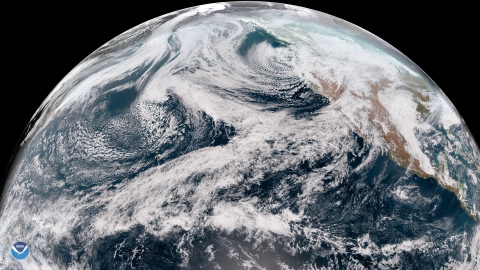The Defense Department leans on the National Oceanic and Atmospheric Administration for weather data across the force, from ship routing to flight safety. Planned reductions to NOAA’s next-generation satellite portfolio now put that pipeline at risk, with direct knock-on effects to the Space Force and combatant commands that rely on those feeds every day.
Internal budget direction circulated in mid-August shrinks NOAA’s future geostationary constellation and trims a separate space-weather line, a combination that narrows civilian and military coverage at the same time. Defense officials confirm the department is assessing the operational gaps if those reductions stand.
Pentagon reliance on NOAA satellite data for SBEM requirements
The U.S. military sets formal space-based environmental monitoring needs through the Joint Staff and the Joint Requirements Oversight Council. They cover cloud and sea-ice characterization, soil moisture, snow depth, ionospheric density and other measurements that feed models used by planners and aircrews.
Space Force leaders describe a “Family-of-Systems” method that combines military satellites with NOAA, NASA, allied and partner sources. Government officials say a majority of today’s priority measurements still come from outside DoD, with NOAA systems providing essential coverage.
At present, the Space Force operates a small weather fleet. Three DMSP spacecraft remain on station near end of life, and one Weather System Follow-on Microwave satellite reached operational status in April. WSF-M adds passive microwave data over the oceans, with products used for ocean surface vector winds, tropical cyclone intensity and charged particle characterization.
According to industry sources, interagency data flows keep day-to-day operations running for the services. It includes weather support to flight decks and ranges, maritime patrol routing and launch commit criteria. The Space Force and NOAA have also built a steady handoff model for aging geostationary satellites that still carry useful imaging sensors.
GeoXO downsizing and impact on GOES transfers to EWS G for Indian Ocean coverage
The administration’s fiscal 2026 budget direction instructs NOAA to pare back the Geostationary Extended Observations program, originally budgeted near $20 billion across three decades.
The passback moves away from the current plan for six fully instrumented spacecraft and pushes NOAA toward a leaner constellation. It pushes remaining hardware toward firm-fixed-price awards rather than the cost-plus structure used to date.
NASA selected Lockheed Martin in June 2024 to build the core GeoXO spacecraft with a potential value of $2.27 billion, and those contracts would need conversion if the passback holds.
Documents and briefings reviewed by reporters in August indicate ripple effects to instrument buys. Reporting points to cancellation of roughly $800 million in awards for two specialized sensors that track air quality and ocean color, with additional study of whether to trim other payloads like an advanced sounder and lightning mapper. NOAA would then meet a lower top line by reducing instrument suites and by flying fewer satellites.
For about a decade, NOAA’s retiring GOES satellites have been transferred to the military and repurposed as Electro-Optical Infrared Weather System Geostationary assets over the Indian Ocean. Those spacecraft extend persistent theater coverage for the Indo-Pacific, a region where carrier and air mobility operations depend on reliable cloud and convection monitoring.
If NOAA trims GeoXO too far or delays first launch into the 2030s, there may not be a healthy GOES-R-era satellite to pass along on time. Space Force and NOAA officials have signaled that without a timely handoff in roughly 2030 to 2032, DoD would need to procure its own geostationary coverage for that sector, which drives cost and schedule pressure back into the Pentagon.
Defense officials confirm they plan to continue the NOAA partnership for Indo-Pacific coverage, but program math will decide how long the transfer model holds. If instrument descopes reduce capability, the military inherits less capable imagers later. If the constellation shrinks, transferable satellites may not exist at all.
According to industry sources, shifting active development to firm-fixed-price midstream normally forces contractors to simplify designs or accept higher risk, which can affect timelines.
WSF M status and EWS prototype launches with remaining coverage gaps
WSF-M reached operational acceptance on April 24. The satellite now delivers ocean surface wind vectors, cyclone intensity and energetic particle data to operational weather units.
A second copy is slated to launch next year, expanding coverage and resilience for oceanic scenes, which are critical for naval routing and amphibious planning. Space Systems Command has also started the second leg of the DMSP replacement effort with electro-optical and infrared imaging prototypes.
The first EWS prototype from General Atomics is planned to launch by December 2026, with a second by September 2028. Those efforts replace aging visible and infrared cloud imagery used by mission planners since the DMSP era.
Even if all of those pieces fly on schedule, the military will still need NOAA data. WSF-M does not collect everything in the Joint Staff’s requirements set. Electro-optical imaging prototypes will take time to calibrate and fold into operations.
Meanwhile, NOAA’s geostationary and polar fleets feed bulk data volumes into the models the services use. Any reduction in geostationary sampling over the Western Pacific and Indian basins lowers the quality of convective monitoring in a region where sortie rates can swing with cloud-top temperatures and upper-level winds.
To make the operational discussion concrete, the department’s priority measurements include, among others:
- Cloud characterization and imagery across day and night scenes
- Sea ice and snow depth for navigation and mobility planning
- Soil moisture and surface winds across ocean basins
- Ionospheric density and charged particle characterization for HF communications and PNT integrity
The Space Force has long described a hybrid model that mixes government-owned platforms with commercial and allied feeds. WSF-M and EWS will help, but they do not replace the wide-field and high-tempo coverage that geostationary imagers and sounders provide over entire theaters.
Space Weather Next reductions and the risk to satellite operations and comms
The same budget direction trims NOAA’s Space Weather Next program by roughly $57 million, narrowing preparations for two observatories at the Earth-Sun L1 point after the Space Weather Follow On mission.
L1 provides upstream solar wind monitoring and coronal imagery that give operators warning of geomagnetic storms. The current plan foresees Space Weather Next launches in 2029 and 2032, providing continuity after SWFO-L1 rides to orbit with NASA’s IMAP mission later this year.
Space weather hits space systems first, which means warning time and particle environment data matter to satellite operators, missile warning radars, and communications planners.
NOAA has begun final launch preparations for SWFO-L1, a rideshare that will extend real-time measurements of solar wind and provide coronal imagery. That mission falls outside the Space Weather Next cuts, but the follow-on architecture needs stable funding to keep the data stream unbroken into the 2030s. Defense officials confirm they plan to pull those data into the Space Force’s Family-of-Systems framework once operational.
Our analysis shows the combined effect of a smaller geostationary weather fleet and a thinner space-weather pipeline lands hardest on warning timelines and confidence levels used by commanders. The military can surge models and manpower, but those efforts only work when sensors upstream keep pace. If NOAA fields fewer geostationary platforms with reduced instrument sets, and if L1 follow-ons slip, the Space Force will need either fresh procurement inside DoD or deeper reliance on allied and commercial sources to keep forecast skill steady in the Indo-Pacific and beyond.
According to industry sources, any pivot to DoD-owned geostationary imaging for the Indian Ocean would run to the high hundreds of millions, likely more, given spacecraft, launch and ground integration. That is why the transfer arrangement with NOAA has proven attractive. Defense officials confirm the department is mapping contingencies.
The Defense-Aerospace editorial team will continue to track the budget process as it moves and report the practical effects for warfighters and program offices.
REFERENCE SOURCES
- https://rollcall.com/2025/07/15/trumps-proposed-noaa-cuts-meet-senate-appropriators-opposition/
- https://www.nesdis.noaa.gov/about/our-offices/office-of-geostationary-earth-orbit-observations
- https://investors.lockheedmartin.com/news-releases/news-release-details/lockheed-martin-awarded-geoxo-lightning-mapper-contract-support
- https://www.nesdis.noaa.gov/news/nasa-selects-lockheed-martin-build-noaas-next-gen-spacecraft
- https://payloadspace.com/noaas-weather-sat-do-over-starts-with-less/
- https://www.spaceforce.mil/News/Article-Display/Article/4165122/first-ussf-wsf-m-satellite-reaches-operational-acceptance-advances-space-based/
- https://www.ssc.spaceforce.mil/Newsroom/Article/4165711/ussf-advances-weather-monitoring-with-operational-acceptance-and-initial-operat
- https://www.ssc.spaceforce.mil/Newsroom/Article-Display/Article/4229218/space-systems-command-set-to-strengthen-operational-environment-with-enhanced-g
- https://breakingdefense.com/2024/07/space-force-revamps-ga-ems-weather-demo-contract-380m-through-2030-second-bird/
- https://breakingdefense.com/2025/08/stormy-weather-dod-faces-dearth-of-data-from-planned-noaa-cuts/
- https://spacenews.com/general-atomics-to-build-second-space-force-weather-satellite/
- https://orion.arcfield.com/press-releases/orion-space-solutions-launches-an-electro-optical%2Finfrared-weather-systems-%28ews%29-satellite-for-u.s.-department-of-defense-support
- https://www.nesdis.noaa.gov/our-satellites/future-programs/space-weather-next
- https://www.noaa.gov/media-advisory/experts-to-preview-launch-of-historic-noaa-space-weather-satellite-observatory



